
Friday, September 14, 2018
6 Best Places to Hire WordPress Developers

Thursday, September 13, 2018
Beginner’s Guide to WordPress User Roles and Permissions
Out of the box when you install WordPress, there are five default user roles:
- Administrator
- Editor
- Author
- Contributor
- Subscriber
Tuesday, September 11, 2018
How to Change the WordPress Admin Email (2 Methods)
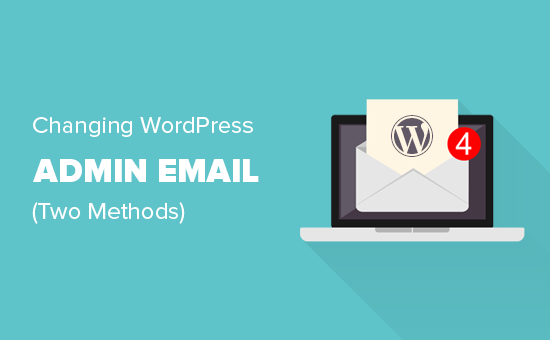
Monday, September 10, 2018
11 Top Reasons Why WordPress Sites Get Hacked (and How to Prevent it)

Friday, September 7, 2018
4 Best Plugins to Convert a WordPress Site into a Mobile App
Are you looking for a solution to convert your WordPress site into a mobile app? More and more people prefer to browse the internet and shop online using their mobile devices. Apps are a convenient way to deliver your content and offer better mobile experience. In this article, we will show you the best plugins to convert WordPress into mobile app.
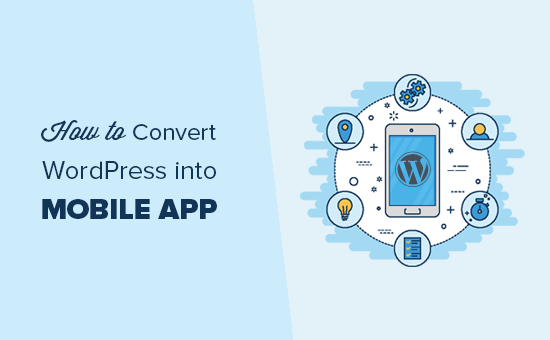
Why Create a Mobile App for Your WordPress Site?
If you check your website traffic in Google Analytics, then you will see that a large number of users are accessing your website from their mobile phones. The easiest way to make sure that mobile users have a nice experience on your website is by making it mobile responsive.
A mobile responsive WordPress website uses a design that automatically adjusts itself to match user’s screen size. Almost all good WordPress themes are mobile responsive out of the box. You can even find great looking mobile responsive themes for WooCommerce.
However, some businesses may want to offer an even nicer user experience by creating their own mobile apps. Instead of visiting your website in a browser, users will be able to launch an app from their home screen to access their favorite blog, online store, membership website, or online community.
Building a mobile app typically requires programming skill, and there are plenty of development agencies that will build a mobile app for your website. However, it would cost you a lot of money ($15,000 and upwards).
If you want to build a mobile app on a budget, then there are few WordPress plugins that can help you convert your WordPress site into a mobile app. All of them are paid solutions, but they cost way less than hiring someone to build a new app for you.
Keep in mind that using these plugins still require intermediate to advanced WordPress skills. If you are an absolute beginner, then we will recommend using a mobile responsive theme and improving your WordPress speed to gain more mobile users.
That being said, here are the best plugins to convert your WordPress site into a mobile app.
1. AppPresser
AppPresser is an easy to use platform that helps you convert any WordPress site into a mobile app. They have a dedicated WordPress mobile theme that can be used to create an app for your blog, WooCommerce store, or BuddyPress website.
It has a visual app customizer to easily change your app’s appearance just like you would do for a WordPress theme. You can customize colors, add custom pages, pull WordPress content, and more. AppPresser offers integrated push notifications which is fairly easy to set up and manage.
2. MobiLoud
MobiLoud allows website owners convert their WordPress sites into mobile apps. They have two products: one for news or blog sites, and another one for websites using WooCommerce or other sophisticated plugins.
It comes with push notifications, mobile advertising support, analytics, and custom branding. The app is configured, prepared, and can also be submitted to app stores for you.
3. Androapp
AndroApp is another useful plugin to convert your WordPress website into a mobile app. It comes with offline support, multiple themes, internationalization supports, unlimited push notifications, infinite scroll, and native social sharing. It does not support WooCommerce or BuddyPress.
The plugin developer will help you configure and download your app which you can then submit to the play store yourself, or hire plugin author to do it for you.
The big downside of this plugin is that the free version allows the developer to show their own ads.
4. WPApp.Ninja
WPApp.Ninja allows you to create a mobile app or a progressive web for your WordPress website. You can purchase a single lifetime license to build your app. All app setup and configuration can be done inside your WordPress admin area.
It gives you easy tools to upload your app icons, buttons, colors, translations, and more. It supports Google Analytics, built-in caching, offline content, and compatibility with all popular WordPress plugins.
If you’re serious about converting your WordPress site into an app, then we recommend using AppPresser or Mobiloud.
We hope this article helped you find the best plugins to convert WordPress site into a mobile app. You may also want to see our guide on how to track user engagement in WordPress with Google Analytics.
If you liked this article, then please subscribe to our YouTube Channel for WordPress video tutorials. You can also find us on Twitter and Facebook.
The post 4 Best Plugins to Convert a WordPress Site into a Mobile App appeared first on WPBeginner.
from WPBeginner https://ift.tt/2Cxkddb
Thursday, September 6, 2018
How to Disable Gutenberg and Keep the Classic Editor in WordPress
Do you want to disable Gutenberg and keep the classic WordPress editor on your site? Gutenberg is an upcoming WordPress editor which will replace the classic WordPress editor. While it looks modern, a lot of users are finding it hard to use and would prefer to keep the classic editor. In this article, we will show you how to easily disable Gutenberg and keep the classic editor in WordPress.
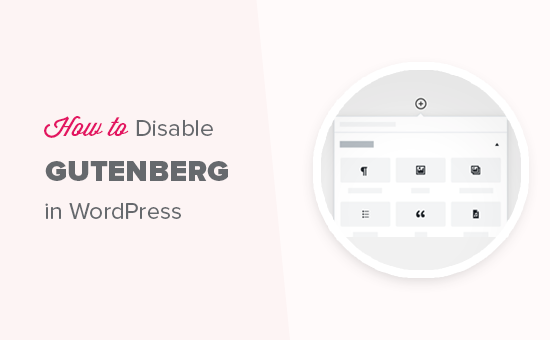
What is Gutenberg?
Gutenberg is an upcoming WordPress editor with a goal to modernize the WordPress writing experience.
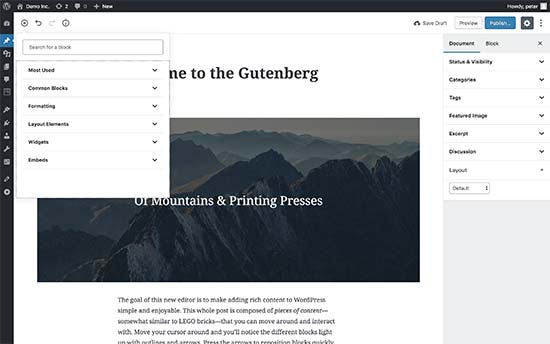
It attempts to work like a page builder plugin and allows you to drag and drop items into a post or page. The goal is to offer more flexibility and enable WordPress users to create unique layouts for their content with rich multimedia content.
Since WordPress 4.9.8, the core WordPress team has added a call to try out Gutenberg in the WordPress dashboard. The purpose of this callout is to get feedback from millions of WordPress users and make Gutenberg ready for its first release.
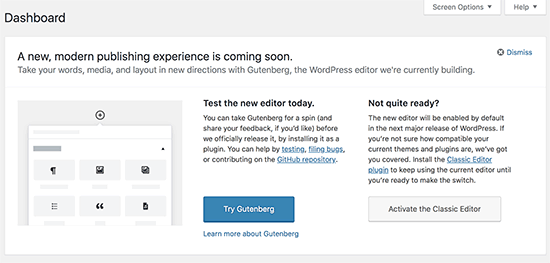
Gutenberg will become the default WordPress editor with the release of WordPress 5.0 which is expected to arrive later this year (2018).
Why Disable the Gutenberg Editor in WordPress?
Many users feel that Gutenberg in it’s current state is not ready for live sites. This is evident by the 2.3 out of 5 rating average on the Gutenberg plugin. At the time of writing this article, there are 676 one-star ratings vs 288 five-star ratings.
Despite the negative reviews, WordPress core team is moving forward with making Gutenberg the default editor in WordPress 5.0.
This is making a lot of users very concerned. They want to have an option to disable Gutenberg and keep the classic editor.
Thankfully, there’s a plugin by the WordPress core team which allows you to do just that.
Let’s take a look at how to easily disable Gutenberg and keep using the classic WordPress editor.
Method 1. Disable Gutenberg with the Classic Editor Plugin
For this method, we will be using the Classic Editor plugin which is developed and maintained by the core WordPress contributors.
First thing you need to do is install and activate the Classic Editor plugin. For more details, see our step by step guide on how to install a WordPress plugin.
The plugin works out of the box, and it will disable the Gutenberg editor upon activation.
This plugin also gives you an option to keep both Gutenberg and the Classic editor at the same time. You can configure this in the plugin’s settings.
Simply go to the Settings » Writing page in your WordPress admin area. You will see the option to do this under “Classic editor settings”.
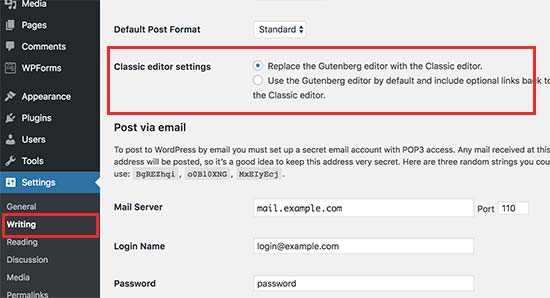
Don’t forget to click on the save changes button to store your settings.
You will now be able to see a new link under the Posts menu to create new posts using the classic editor.

You will also be able to edit older articles using the classic editor. Simply go to Posts » All Posts page and you’ll see a ‘Edit (Classic)’ link below posts.
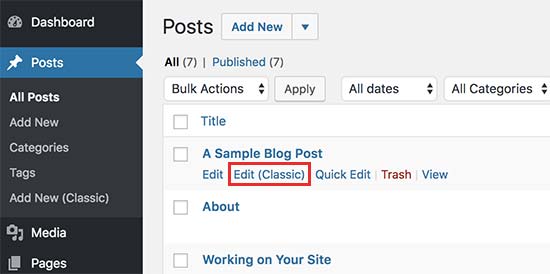
Method 2. Use Classic Editor with Disable Gutenberg Plugin
If you want to disable Gutenberg for certain user roles and post types, then this method will help you do that.
First, you need to install and activate the Disable Gutenberg plugin. For more details, see our step by step guide on how to install a WordPress plugin.
Upon activation, you need to visit Settings » Disable Gutenberg page to configure plugin settings.
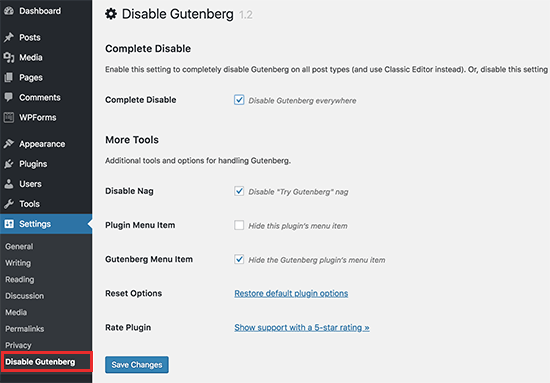
By default, the plugin will disable Gutenberg everywhere for all users on your website. However, if you want to limit it to certain user roles and post types, then you need to uncheck the ‘Complete Disable’ option.
Unchecking it will display more options to selectively disable Gutenberg for certain user roles, post types, theme templates, or individual posts.

This option is helpful if you are using a WordPress plugin that’s not compatible with Gutenberg, but you want to use Gutenberg for other areas on your site.
WordPress is the world’s most popular website builder powering more than 31% of all websites on the internet.
It has thousands of plugins and themes and powers all kind of websites from eCommerce stores to membership communities.
A lot of these third-party tools rely heavily on the classic WordPress editor. The core team is trying to give developers enough time to make their plugins and themes compatible with Gutenberg. However, it is possible that many of these will not be fully compatible with the Gutenberg editor.
If that’s the case, then these settings could be very helpful for you.
Don’t forget to click on the save changes button to store your settings.
We hope this article helped you disable Gutenberg and keep the classic editor in WordPress. You may also want to see our list of the most wanted WordPress tips, tricks, and hacks.
If you liked this article, then please subscribe to our YouTube Channel for WordPress video tutorials. You can also find us on Twitter and Facebook.
The post How to Disable Gutenberg and Keep the Classic Editor in WordPress appeared first on WPBeginner.
from WPBeginner https://ift.tt/2CqcTA1
Wednesday, September 5, 2018
What is WordPress VIP? What are the Benefits? (And 3 Alternatives)
Recently, one of our readers asked us about WordPress VIP and its benefits? WordPress VIP is a managed WordPress hosting service for enterprise and large-scale websites. In this article, we will explain what is WordPress VIP, what are the benefits, and what are some good alternatives for it.

What is WordPress VIP?
WordPress VIP is a high-end managed WordPress hosting platform for enterprise and large-scale websites.
It is said to be the fastest, most secure, and totally hassle-free WordPress hosting that you can buy. Aside from the high cost, WordPress VIP has very strict coding standards and processes which means it’s not suitable for most companies.
Who Should Use WordPress.com VIP?
WordPress.com VIP is a powerful hosting plan designed specifically to handle high-traffic volume with unrivaled performance and security.
It is suitable for large businesses and high-traffic websites with tens of millions of page views.
WordPress.com VIP pricing is a mystery because the website does not have a public pricing page. However research shows that plans range from $5,000 to $25,000 per month for up to 5 websites wit ha minimum $5,000 USD setup fee per-site.
For that price, you will get unlimited storage, bandwidth, CDN, and dedicated support.
Here are some of the top brands that are already using WordPress VIP.






Benefits of WordPress VIP
WordPress.com VIP is in it’s own class because it takes away the pain associated with managing a mission-critical, high traffic content-rich website. Here are some of the key benefits of using WordPress.com VIP:
1. Fully Managed WordPress Platform
WordPress.com VIP is more than a managed WordPress hosting platform. It includes the following managed services:
- Automated hourly backups
- Proactive security and scanning
- Automatic updates for core software
- Review process for third-party plugins and custom code
- Uptime and performance monitoring
- Automatic scaling to handle massive traffic spikes without a blink
It is like having your own development team taking care of everything for you without any downtime to your website.
2. Planning & Training
Each WordPress.com VIP plan starts with a detailed planning and strategy assessment of your website. During this time, WordPress.com’s VIP team will work with your team to review your needs and what you want to do.
The team will also help you pick the theme (website design) and WordPress plugins for your project. If you already have a theme developed, then they will review every line of the code. Same goes for third-party plugins and all custom code to make sure that it is compatible with the platform’s coding and security standards.
They will train your development team about the platform, security, and performance. This training also extends to your website’s editors, authors, and administrators, so that they can make the most out of the WordPress VIP’s robust content management and publishing features.
3. Best Performance & Blazing Fast Speed
The entire hosting platform for WordPress.com VIP is optimized to offer the best WordPress performance. You don’t have to worry about caching, code optimization, CDN service, or plugins.
The WordPress VIP platform is served by a delivery network of 20 data centers across the globe. This offers you the best time-to-first byte result, latency, SSL security, and protection against DDOS attacks.
4. The Best WordPress Security
All WordPress.com VIP websites are protected by a custom built infrastructure and WordPress security best practices to proactively block brute force and other types of attacks. All your website traffic will be fully encrypted from edge to origin.
Every piece of custom code is reviewed manually, which adds another security layer to protect your website from running potentially vulnerable code.
Alternatives to WordPress.com VIP
Despite it’s advantages, WordPress.com VIP is not for everyone primarily because of the cost. However many companies don’t like the additional restrictions and processes that they have to go through to push changes on their website.
Thankfully due to the growth of WordPress, there are other WordPress hosting providers that have stepped up to offer similar levels of hosting plans as WordPress.com VIP.
Here is our pick of the top alternatives to WordPress.com VIP that are offering enterprise grade hosting services for e-commerce and high-scale websites.
1. WP Engine
WP Engine is the most popular managed WordPress hosting service on the market. Their enterprise offering is also the top WordPress.com VIP alternative for high-traffic websites and enterprise clients.
WP Engine’s enterprise plan is a high redundancy, scalable, and fully managed hosting solution. Their platform is built on top of Amazon web services and Google Cloud Platform with custom optimizations. On top of that, they use their own proprietary caching solution to improve page load speed.
It also includes global CDN, managed onboarding, dedicated support response, and 24/7 performance and security monitoring.
WP Engine hosts top websites including Under Armour, AMD, SoundCloud, JobVite, Thomson Reuters, and more.
2. Liquid Web
Liquid Web is another reliable managed WordPress hosting provider offering multiple levels of hosting plans, including custom plans for enterprise clients. They serve many big name brands including Motorola, Red Bull, ESPN, and United Way.
They own their own data centers and offer 24/7 US based support via phone, live chat, and email. All their managed hosting plans have no overage charges, managed plugin updates, and no limits on which plugins you use on your WordPress site.
3. SiteGround
SiteGround is an officially recommended WordPress hosting provider that has recently entered the Enterprise hosting space. They specialize in offering completely custom infrastructure designed specifically for your needs. Their service is 100% managed, and you get dedicated support team that works alongside you 24/7 all year round.
Last year, we switched all of our eCommerce websites including WPForms, MonsterInsights, and OptinMonster to SiteGround Enterprise structure, and we cannot be happier with the decision. Their support is absolutely top-notch available through Slack, email, and direct personal phones.
We hope this article helped you learn more about WordPress VIP, its benefits, and alternatives. You may also want to see our list of must-have WordPress plugins for business websites.
If you liked this article, then please subscribe to our YouTube Channel for WordPress video tutorials. You can also find us on Twitter and Facebook.
The post What is WordPress VIP? What are the Benefits? (And 3 Alternatives) appeared first on WPBeginner.
from WPBeginner https://ift.tt/2LZ5RBC
Tuesday, September 4, 2018
Beginner’s Guide: How to Choose the Best WordPress Plugin
Plugins make WordPress a dream come true for beginners. However, with over 56,000 WordPress plugins available in the official plugin directory, users find it difficult to find the right WordPress plugin for the job. In this article, we will show you how to choose the best WordPress plugin by following the same checklist that our team at WPBeginner and other WordPress experts follow.
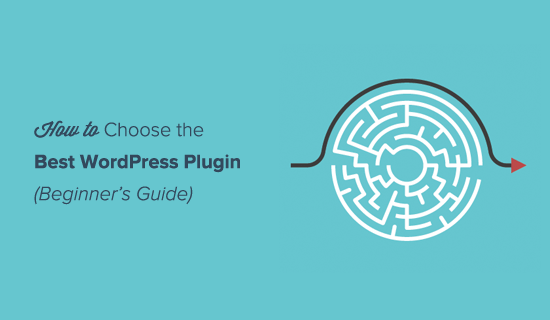
Disclaimer: While these factors won’t guarantee that you’ll pick the right plugin 100% of the time, it will definitely increase your chances of success.
Before You Start
When looking for a plugin, the first thing you should do is write down exactly what you want this plugin to do. In our experience, it helps if you create a checklist with features that you’re looking for (in the order of importance).
The order of importance matter because sometimes you won’t find everything in one plugin. The importance factor will help make your decision easier.
Remember that it doesn’t have to be one plugin that does everything. If you find two plugins that work well together to give you what you need, then install those 2 plugins. The total count of plugins does not matter, the quality does.
Having said that, let’s take a look at how to choose the best WordPress plugin.
How to Search for a Plugin
WordPress plugin directory is the starting point for most people. It has thousands of plugins available which is great except that this abundance also makes it difficult to find the perfect plugin.

The search feature in WordPress plugin directory is not very sophisticated. This is why we always recommend using Google search or look through the WPBeginner’s plugins category first.
You can also combine the best of both by typing your keyword in Google search and add wpbeginner at the end of it.
Alternatively, you can start by browsing the most popular WordPress plugins in the directory. See if there is a plugin that fits your need. If you can’t find a plugin in the first two pages of popular plugins, then run a search.
WordPress plugin directory search shows results based on relevance by default.

For each search result, you will be able to see the Plugin name, rating, description, number of active installs (websites using the plugin), author name, and tested with WordPress version.
Ideally, you want to choose a plugin that sounds relevant to you, has a decent number of active installs, a good rating, and tested with a recent WordPress version.
Comparing Plugins – Which One to Download?
Once you have found a couple of plugins, you can open these plugin pages in new tabs to compare them. WordPress plugin page contains information about the plugin, what it does, how to use it, etc. You will need to use this information to decide whether or not this plugin is the best fit for you.

The sidebar on plugin page contains useful information about the plugin. The first section in the sidebar shows the plugin version, last updated, active installations, minimum WordPress version required to run the plugin.
A plugins last updated date and active installs are a good indicator of a plugin’s popularity.
This section will also show tested up to WordPress version. If it doesn’t show the most recent version, then there is no need to freak out. Although plugin authors check their plugin with each new WordPress release, they may only update the plugin if needed. Please see our article about installing plugins not tested with your WordPress version for more details.
Plugin Ratings
In the sidebar of plugin page, you will also be able to see plugin ratings. The number of stars indicates rating score, where five is the highest and one being the lowest.
You should always keep in mind that a lot of WordPress users use the plugin without rating it. It is possible that a plugin downloaded by thousands of people may still not have enough people rating it.

Plugin Reviews
When a user rates a plugin, they are asked to write a review for their rating. You can see these reviews by clicking on the rating bars. For example, if someone has given a plugin one star then you can click on the 1 star link to read their review.
Another thing to notice here is the total number of ratings. For example, if a plugin only has one or two people rating it, then it is really not a significant number. However, if those one or two people left a good reason for their rating in the review, then this would make their rating significant for others.
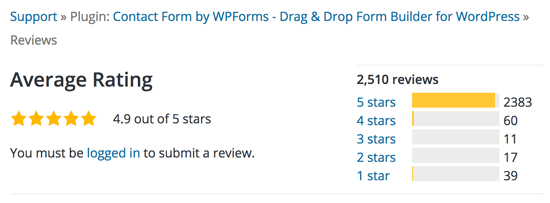
Support Overview
The support section of the plugin page’s sidebar will give you a quick overview of the number of support threads opened for a plugin during last two months. It will also show you how many of these threads are resolved.
You can see support threads by clicking on the support tab in the plugin menu bar. Just like the reviews, keep in mind that unresolved support threads do not really mean that the plugin has some issues.
However, if a plugin has many unresolved threads and the plugin author has not responded to any of them in last two months, then this could be an indicator that the author has lost interest. The plugin may still work for you, but it may not be supported in the long run.

Plugin Screenshots
For most WordPress plugins in the directory, you will see a screenshots section below the plugin description. Plugin screenshots are a quick way to see how the plugin looks on the front-end and on the back-end of your WordPress website.
Sometimes we find screenshots to be more helpful than the actual plugin descriptions which could be lengthy and confusing. With screenshots, you can actually see how the plugin will look, what it actually does and then you can quickly find out whether or not you should try it.
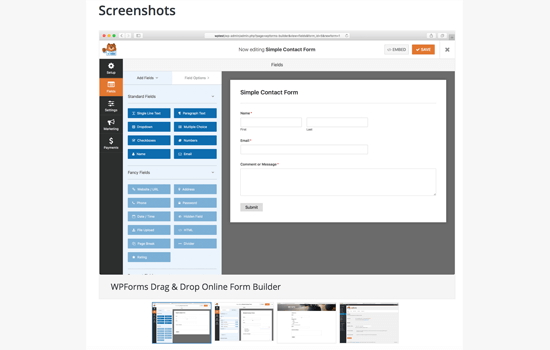
Check FAQs and Other Notes
Don’t forget to check FAQs, and Other Notes sections below the plugin description (Some plugins may not have them). These sections usually contain useful information about how to use a plugin. Sometimes users end up complaining that a plugin does not work without even reading how to use it.
When you are trying a plugin, make sure you read these sections so that you can configure and use the plugin properly on your website. It is also possible that you will find some other cool tips there.
For example, if you are a looking for a plugin that adds a widget, then you might find out that it also provides a template tag which you can use in your theme or a shortcode which you can use in posts and pages. You may also find out plugin author’s advice on how to add your own CSS styles to plugin output.

Testing a Plugin
WordPress plugins may slow down your website if they are poorly written or don’t follow WordPress coding standards.
To check for this problem go to Pingdom or any other site speed checking service. Test your website’s page speed before activating the plugin. Take screenshots or note down the results.
After that, go back to your WordPress website and activate the plugin. Now test your website speed again.
If the plugin adds a significant amount of time to your site’s speed, then you should try finding a better plugin.
For example, in the screenshot below you will see that a plugin has added extra 0.8 seconds to our test site’s load time making it significantly slower.
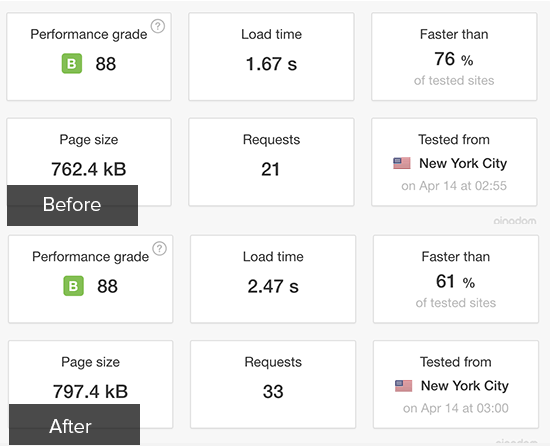
Giving back to the WordPress Community and Plugin Authors
WordPress is a free community software and so is the WordPress Plugin Directory. Plugin authors put a lot of their time, hard work, and creativity in writing those plugins. You can help them in many ways and here is a list of things you can do:
- Donate: If you find a plugin useful and the plugin author has donate URL on plugin page, then please consider donating some money. It is not the price of the plugin, it is a token of appreciation.
- Rate the plugin: As we mentioned earlier that a lot of users don’t feel much inclined to rate a plugin that works fine. You can help break this trend. When you find a plugin that you like, then leave a rating and a review. A few lines are good enough to let people know about your experience with the plugin.
- Mention the plugin on your blog, Twitter or Facebook.
What to do When a Plugin Doesn’t Work
If a plugin gives an error or does not work, then the first thing you would want to do is find out if it is having a conflict with another plugin or theme. Deactivate all other plugins and activate default WordPress theme. Try testing the plugin again. If it still does not work, then you might want to open a support thread.
Visit the plugin page on WordPress plugin direcory and click on Support tab. Scroll down till you find the support form and fill it out.
Remember, that WordPress plugins are open source which means that they come with no warranty at all and the plugin authors are not required to answer your questions. However, most plugin authors care about their code and will try their best to answer support questions whenever they can. Check out our guide on how to properly ask for WordPress support and get it.
We hope this guide helped you choose the best WordPress plugin. You may also want to see our expert-pick of the essential WordPress plugins for every website.
If you liked this article, then please subscribe to our YouTube Channel for WordPress video tutorials. You can also find us on Twitter and Facebook.
The post Beginner’s Guide: How to Choose the Best WordPress Plugin appeared first on WPBeginner.
from WPBeginner https://ift.tt/2oDDWOp
Monday, September 3, 2018
How to Start a Travel Blog (to Make Money or Otherwise) in 2018
Do you want to start a travel blog but don’t know where to begin? Travel blogs are a popular medium to share your travels with not just family and friends but also with the rest of the world. In this guide, we will walk you through how to properly start a travel blog and even make money from it without any special technical skills.

What do you need to start a travel blog?
There are three things you need to properly start a travel blog.
- A domain name (this will be your blog’s name that people will type to find your site e.g. wpbeginner.com)
- Web hosting account (this is where your website files are stored on the internet)
- Your undivided attention for 30 minutes.
Yes, you can get started with a proper professional-looking travel blog in less than 30 minutes. We will walk you through the process every step of the way.
In this step by step tutorial, we will cover the following items.
- How to Register a Domain Name for Free
- How to Choose the Best Web Hosting
- How to Install WordPress
- How to Find the Perfect Theme (website design) for a Travel Blog
- How to Add Content to Your Travel Blog
- How to Get More Traffic to Your New Blog
- How to Make Money from Your Travel Blog
- Resources to Learn WordPress and Grow Your Travel Blog
That being said, let’s get started.
Step 1. Choosing The Right Platform
For most beginners, the biggest mistake is not starting with the right blogging platform. Since you are already here, you will not be making that mistake.
We recommend using WordPress.org. It is the most powerful and popular blogging platform in the world giving you complete freedom to start, grow, and make money from your blog. For more details, see our complete WordPress review.
It is important not to confuse WordPress.org with WordPress.com, as they are two different platforms. WordPress.com is a hosted solution and WordPress.org is a self-hosted platform. For more on this topic, see our comparison of WordPress.com vs WordPress.org.
To start a travel blog with WordPress.org, you will need a domain name and a WordPress hosting account. To learn more, see our article on the difference between domain name and web hosting.
Normally, a domain name costs $14.99 / year and web hosting normally costs $7.99 / month.
That’s a lot for beginners who are just starting their travel blog.
Thankfully, Bluehost has agreed to offer our users a free domain name and discount on web hosting. They are one of the largest hosting companies in the world and officially recommended by WordPress.org.
→ Click Here to Claim This Exclusive Bluehost Offer ←
Basically, you’ll be able to get started for just $2.75 per month.
Bluehost is committed to giving back to the WordPress community since 2005. They have promised us that if you cannot get your blog setup within 30 minutes by following this tutorial, then our expert team will complete the process for you without any cost. They will compensate us, so you don’t have to. Simply contact us for free blog setup help.
Note: At WPBeginner we believe in full transparency. If you sign up with Bluehost using our referral link, then we will earn a small commission at no extra cost to you (in fact you will save money and get a free domain + free SSL). We would get this commission for recommending just about any WordPress hosting company, but we only recommend products that we use personally use and believe will add value to our readers.
That being said, now let’s go ahead and purchase your domain name and hosting for your travel blog.
First, you need to open the Bluehost website in a new browser tab and click on the green get started button.

Next, you will be asked to select the plan that you want (basic and plus are the most popular among our users).
After that, you will be asked to enter the domain name for your website.

Tip: Make sure your domain name is easy to pronounce and spell. You can also use keywords that you think people will search when looking for a travel blog. This will help you get more traffic from Google search. For more tips, see our guide on how to choose the best domain name for your blog.
After choosing your domain name click on the next button to continue.
Now, you will need to add your account information and finalize the package information to complete the process. We recommend going with the 36-month plan because that’s the best value.
You will also see some optional extras that you can purchase. We don’t recommend purchasing them right away. You can always add them later on if you decide that you need them.
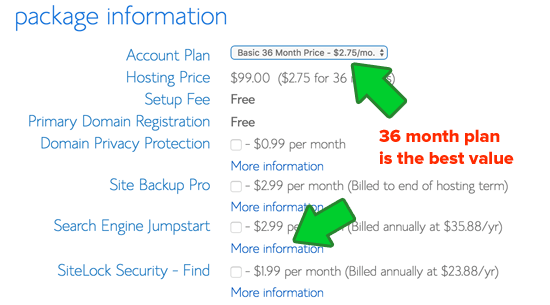
After that, you need to enter your payment information and finish the purchase.
Once finished, you will receive an email with details on how to login to your web hosting control panel (cPanel).
Step 2. Installing WordPress
This step is not required as Bluehost will automatically install WordPress on your domain name. You just need to click on the link in the email you received after sign up.
This will take you to your hosting control panel. From here, you can just click on the login to WordPress button to enter your WordPress site’s admin dashboard.
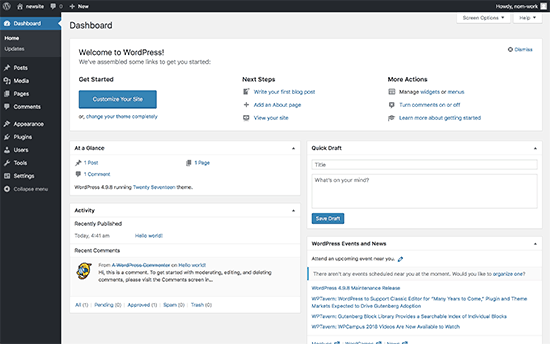
Now you are ready to customize your travel blog’s appearance and start adding content.
Step 3. Choosing a Theme for Your Travel Blog

Themes are one of the best things about WordPress. They control your website’s design and appearance and there are thousands of free and paid WordPress themes to choose from.
WordPress is used by all kind of websites so WordPress themes come with lots of choices. A WordPress theme designed for business websites may not look so great for a travel blog.
You will need a theme that matches the look and feel of a travel blog. The trick here is to strive for simplicity and find the perfect balance between functionality and design.
Need to look at some great examples? See our expert pick of the best WordPress themes for travel blogs.
After you have found a suitable theme, head over to our guide on how to install a WordPress theme for step by step installation instructions.
Step 4. Adding Content to Your New Travel Blog
After you have installed and set up a WordPress theme, the next step is to start adding content. WordPress comes with two default content types, they are called posts and pages. While the posts will be the entries in your travel blog, pages are for adding static content to your website.
We recommend adding the static content first because it helps you build a structure for your website. For example, contact form page, about us page, privacy policy page, and more. See our list of important pages that every WordPress blog should have.
Next, you would want to start adding articles and posts to your travel blog. Go to Posts » Add New page to add your first blog post.

You can add any type of content you want. You can write articles, add images, create image galleries, embed videos, audio, and more.
For more details, see our guide on how to add a new blog post in WordPress and utilize all the features.
Step 5. Content Ideas for a Great Travel Blog

Your travel blog posts are where you will develop your own voice and engage your audience. They need to be informative, entertaining, and helpful.
You may be able to quickly add first few posts but it will get harder to regularly come up with new ideas for your blog posts. Check out this massive list blog post ideas that are proven to work, and you can easily use them for your travel blog.
We also recommend you to regularly visit popular travel blogs to get inspiration for your own blog post ideas. See what these top blogs are doing and replicate that on your own blog.
We are not advising you to steal or reproduce the same content. You just need to get the ideas, inspiration, and topics and then use them to create unique content with your own voice, style, and flavor.
You will also notice that popular travel blogs publish quite regularly. That’s because maintaining a consistent frequency is the key to successful blogging. You need to stick with a consistent frequency for your artilces. We recommend starting with three articles a week and gradually build up your pace to 5 articles a week.
Step 6. Getting More Traffic to Your Travel Blog
Once you start adding content to your travel blog, the next step is to help users find your website. To do this, you need to do take the following steps.
1. Work on Your Blog’s SEO

Search engines are the primary source of traffic for most websites and blogs on the internet. They recommend website owners to use certain best practices to increase their site’s visibility in search results. These best practices are called SEO or search engine optimization.
WordPress is very SEO friendly out of the box. However, there is much more that you can do to drive even more traffic to your travel blog. For detailed step by step instructions, follow our ultimate WordPress SEO guide for beginners.
2. Improve Website Speed and Performance

No one likes a slow website. Your users will leave your website instantly with a bad user experience and you will probably never get them again. It also affects your website’s search rankings as Google considers speed one of the top ranking factors.
You will not to perform certain WordPress performance adjustments to speed up your website. We have a complete guide with step by step instructions to improve your WordPress speed and performance.
3. Track User Statistics

Most beginners use their best guesses to decide what their users will like to read or view. You don’t need to do that when you can get actual data to show you exactly what your users want and do on your website. Using this data you can make informed decisions to plan your content strategy and grow your website.
To get these insights you need to start using Google Analytics. It tells you how many people are visiting your website, what they see, where they come from, and more.
For instructions, see our article on how to install Google Analytics in WordPress for beginners.
Google Analytics offers a ton of data. However, as a beginner, you may not know what to look where and which reports to monitor.
To answer these questions, we have made a beginners guide on how to easily track user engagement in WordPress with Google Analytics.
4. Make a YouTube Channel

YouTube is not only the world’s largest video sharing website, it is also the world’s second most popular search engine. You can create a YouTube channel for free and start uploading your travel videos, vlogs, and travel tips videos.
Travel channels are huge on YouTube. In fact, there are already travel vloggers on YouTube making six-figure income through sponsorships, advertisements, and brand endorsements.
Even if you don’t want to become a YouTuber, you can still use the platform to drive traffic to your travel blog.
Step 7. Making Money From Your Travel Blog
Ever wondered how these top travel bloggers go to all these exotic locations all over the world. Travelling is quite expensive and some of these travel bloggers do nothing else but travel. How do they make money?
Here we will tell you how other travel blogs make money and how you can do the same with your travel blog.
1. Sponsorships
The traveling perks for most famous travel bloggers are sponsorships. These sponsorships come from hotels, airlines, cruise ships, tour operators, and even government agencies promoting tourism.
Once your blog reaches a decent amount of regular traffic, you can reach out to these organizations on your own. In return for free stuff, they would want you to mention their place or service on your blog.
How do you find out who would be interested in such a deal? See which other companies are already sponsoring other travel bloggers, or randomly try your luck with hotels and airlines for the places you want to visit.
While sponsorship deals will give you some perks, they will not make money for you.
2. Advertisements
Not just travel blogs, but almost all popular blogs on the internet rely on advertisements. The most popular way to display ads on your blog is by using Google AdSense.
It connects bloggers like you to the advertisers looking for a targeted audience. Advertisers pay Google, which pays you after taking a small cut of their own. For details see our article on how to how to add Google AdSense to your WordPress blog.
3. Affiliate Marketing
Affiliate marketing enables you to recommend travel products that you use and love. You get a referral commission when your users purchase a product after clicking on your link.
To make money with affiliate marketing, you will need to find travel products and brands with an affiliate program. These could be backpack manufacturers, adventure cameras, selfie sticks, travel insurance companies, tour companies, and so on.
The biggest affiliate partner you can sign up for is Amazon Affiliates. They have tons of products in travel gadgets, accessories, luggage, bags, clothing, electronics, and more.
Need help getting started? See our beginner’s guide to affiliate marketing with step by step instructions and tools you will need to succeed.
4. YouTube Travel Vlogger
As we have mentioned earlier, YouTube provides lots of opportunities to travel bloggers. Since videos are much more engaging than plain text or even photos, top brands and advertisers are spending big dollars on YouTube promotions and ads.
YouTube runs its own advertising program too which will generate you some revenue. However, it will help you connect with brands and advertisers while getting new subscribers and followers at the same time.
Step 8. Mastering Your WordPress Skills
WordPress is quite easy to use and manage. However, there is a learning curve involved whenever you start with a new platform. You will continue discovering new things to learn. This is where WPBeginner can help.
WPBeginner is the largest WordPress resource site for beginners. We have lots of helpful content which is created specifically for beginners, business owners, and bloggers.
Following are few of the helpful resources you will find on WPBeginner (all of them are completely free).
- WPBeginner Blog – The central place for all our WordPress tutorials and guides.
- WPBeginner Dictionary – Our WordPress glossary is the best place to familiarize yourself with the WordPress lingo
- WPBeginner Videos – New WordPress users can start with these 23 videos to master WordPress.
- WPBeginner on YouTube – Need more video instructions? Subscribe to our YouTube channel with more than 110,000 subscribers and 10 Million+ views.
- WPBeginner Blueprint – Check out plugins, tools, and services we use on WPBeginner.
- WPBeginner Deals – Exclusive discounts on WordPress products and services for WPBeginner users.
Many of our users use Google to find answers on WPBeginner by simply adding ‘wpbeginner’ at the end of their search term.
We hope this article helped you learn how to start a travel blog and make money from it. You may also want to see our list of essential WordPress plugins for new websites.
If you liked this article, then please subscribe to our YouTube Channel for WordPress video tutorials. You can also find us on Twitter and Facebook.
The post How to Start a Travel Blog (to Make Money or Otherwise) in 2018 appeared first on WPBeginner.
from WPBeginner https://ift.tt/2Cb1MuH






